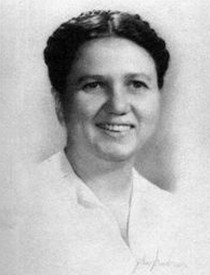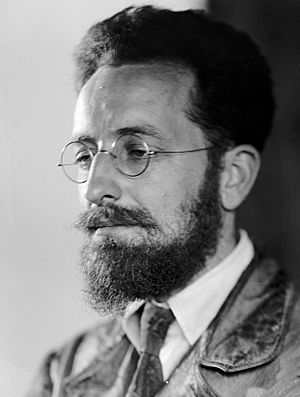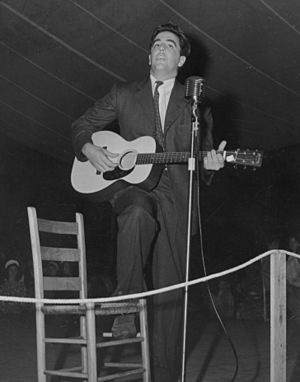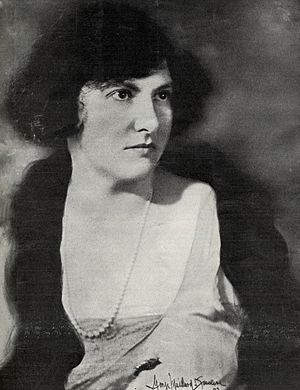Ruth Crawford Seeger facts for kids
Quick facts for kids
Ruth Crawford Seeger
|
|
|---|---|

Ruth Crawford Seeger
|
|
| Born |
Ruth Porter Crawford
3 July 1901 East Liverpool, Ohio, USA
|
| Died | 18 November 1953 (aged 52) |
| Occupation |
|
Ruth Crawford Seeger (born July 3, 1901 – died November 18, 1953) was an American composer and expert in folk music. She was a key figure in modern music and part of a group called the "ultramoderns." Even though she wrote most of her music in the 1920s and 1930s, she later focused on folk music until she passed away. Her music inspired other composers, like Elliott Carter.
Contents
Early Life and Music (1901–1921)
Ruth Crawford was born in East Liverpool, Ohio. Her father, Clark Crawford, was a minister, and her mother was Clara Graves Crawford. Her family moved several times when she was young. They lived in Ohio, Missouri, and Indiana. In 1912, they moved to Jacksonville, Florida. Sadly, her father died there two years later from tuberculosis. After his death, her mother opened a boarding house to support the family.
Ruth loved writing poetry from a young age. As a teenager, she dreamed of becoming a writer or poet. She also started playing the piano when she was six. In 1913, she began piano lessons with Bertha Foster. Foster had started a music school in Jacksonville. In 1917, Ruth studied with Madame Valborg Collett. Collett was a very respected teacher at Foster's school.
After finishing high school in 1918, Ruth wanted to become a concert pianist. She kept studying with Collett and played at many music events. She also taught piano at Foster's school. Ruth wrote her first songs for her young students in 1918 and 1919.
Becoming a Composer (1921–1953)
Chicago Days (1921–1929)
In 1921, Crawford moved to Chicago. She joined the American Conservatory of Music. At first, she planned to stay for just one year to get a teaching certificate. In Chicago, she heard symphony and opera for the first time. She also saw famous pianists like Sergei Rachmaninoff play. At the Conservatory, she studied piano.
Ruth soon changed her focus from playing piano to writing music. In her second year, she began studying how to compose. She wrote early pieces like a Nocturne for Violin and Piano (1923). Her mother moved to Chicago to live with her in 1923. The next year, Ruth earned her music degree. She then started a master's degree program.
Ruth continued her composition studies until 1929. In 1924, she also took private piano lessons. Her new teacher, Djane Lavoie-Herz, greatly influenced Ruth. Herz introduced Ruth to new ideas and the music of Alexander Scriabin. Through Herz, Ruth met other important composers like Dane Rudhyar and Henry Cowell. These composers had a big impact on Ruth's music. During this time, Ruth also met the poet Carl Sandburg. She later set some of his poems to music.
New York Adventures (1929–1936)
Ruth spent the summer of 1929 at the MacDowell Colony. She received a scholarship to be there. She became friends with another composer, Marion Bauer. She also started working on her "Five Songs" based on Sandburg's poems. In the fall, Crawford moved to New York. She lived with Blanche Walton, a supporter of music. There, she began studying composition with Charles Seeger.
In 1930, Ruth made history. She was the first female composer to win a Guggenheim Fellowship. This allowed her to travel to Berlin and Paris. She tried to get her fellowship renewed, but it was not approved. During this time, she talked to Emil Hertzka about publishing her music. He told her it would be "particularly hard for a woman to get anything published."
Crawford then traveled to Vienna and Budapest. She met famous composers like Alban Berg and Béla Bartók. She wanted to discuss her music and get help with publishing it. Even though she was around many modern German composers, she chose to study and compose alone. Charles Seeger's ideas, sent by letter, were very important to her music style. Ruth and Charles Seeger married in 1932 after her trip to Paris. In 1933, her Three Songs were performed in Amsterdam. They represented the United States at a big music festival.

Washington and Folk Music (1936–1953)
In 1936, Ruth Crawford Seeger and her family moved to Washington, D.C.. This was because Charles got a job with the government's music division. In Washington, Ruth worked closely with John Lomax and his son Alan Lomax. They worked at the Archive of American Folk Song at the Library of Congress. Their goal was to save and teach American folk music.
Ruth's versions of traditional American folk songs are highly respected. She wrote down music for books like American Folk Songs for Children. Other books included Animal Folk Songs for Children (1950) and American Folk Songs for Christmas (1953). She also worked on Our Singing Country and Folk Song USA by John and Alan Lomax. Her most famous work from this time is Our Singing Country (1941). She also wrote "Rissolty, Rossolty"–An American Fantasy for Orchestra. This piece was based on folk tunes for a radio show.

In early 1952, she returned to writing modern music with her Suite for Wind Quintet. But in 1953, she passed away from intestinal cancer in Chevy Chase, Maryland. She was buried in Springfield, Massachusetts.
Her Family
Ruth married Charles Seeger in 1932. They had several children: Mike Seeger, Peggy Seeger, Barbara, and Penny. Her stepson was Pete Seeger. The children called their mother "Dio." Many of her children became important folk music artists. However, they knew little about their mother's earlier life as a leading modern composer.
Her Music Style

The music Ruth Crawford Seeger wrote in Chicago from 1924 to 1929 shows the influence of Alexander Scriabin. It also shows the influence of Dane Rudhyar and her piano teacher, Djane Lavoie-Herz. Experts call this her "first distinctive style period." Her music from this time used strong, clashing sounds and unusual rhythms. It also had a spiritual feeling. Some pieces from this period include Five Preludes for Piano and Five Songs on Sandburg Poems (1929).
Crawford Seeger is most famous for her New York compositions. She wrote these between 1930 and 1933. In these works, she used special techniques like "dissonant counterpoint." This means using notes that clash in a planned way. She also used "serial" techniques, which involve repeating patterns of notes. She was one of the first composers to use these serial patterns for more than just notes. Her husband, Charles Seeger, helped her develop these ideas. They even worked together on a book about this type of music.
Her String Quartet 1931 is her most famous work. The third part of this piece is especially well-known. In this part, the music gets louder and softer in a special way. This creates a long melody that goes through the whole section.
Her Compositions
Early Works
- Little Waltz, for piano, 1922
- Piano Sonata, 1923
- Theme and Variations, for piano, 1923
- Little Lullaby, for piano, 1923
- Jumping the Rope (Playtime), for piano, 1923
- Caprice, for piano, 1923
- Whirligig, for piano, 1923
- Mr Crow and Miss Wren Go for a Walk (A Little Study in Short Trills), for piano, 1923
- Kaleidoscopic Changes on an Original Theme, Ending with a Fugue, for piano, 1924
- Five Canons, for piano, 1924
- Piano Preludes No. 1–5, 1924–25
- Adventures of Tom Thumb, 1925
- Sonata for Violin and Piano, 1926
- Two Movements for Chamber Orchestra (Music for Small Orchestra), 1926
- We Dance Together, for piano, 1926
- Piano Preludes No. 6–9, 1927–28
- Suite No.1, for five wind instruments and piano, 1927, revised 1929
- Suite No. 2, for four strings and piano, 1929
- Five Songs to Poems by Carl Sandburg: Home Thoughts, White Moon, Joy, Loam, Sunsets, 1929

Middle Works
- Piano Study in Mixed Accents (three versions), 1930
- Four Diaphonic Suites: No.1 for oboe or flute, No.2 for bassoon and cello (or two cellos), No.3 for two clarinets, No.4 for oboe (or viola) and cello, 1930
- Three Chants for Female Chorus: To an Unkind God, To an Angel, To a Kind God, 1930
- Three Songs to poems by Carl Sandburg, for contralto, piano, oboe, percussion and optional orchestra: Rat Riddles, Prayers of Steel, In Tall Grass, 1930–1932
- String Quartet, 1931
- Andante for Strings (after String Quartet Slow Movement), 1931
- Two Ricercare to poems by H.T. Tsiang: Sacco, Vanzetti; Chinaman, Laundryman, 1932
- The Love at the Harp, 1932
Later Works (Folk Music)
- Nineteen American Folk Songs for Piano, 1936–1938
- Rissolty, Rossolty, 1939–1941
- American Folk Songs for Children, 1948
- Animal Folk Songs for Children, 1950
- Suite for Wind Quintet, 1952
- American Folk Songs for Christmas, 1953
Songs (Date Unknown)
- Songs: Those Gambler's Blues, Lonesome Road, Lord Thomas, Sweet Betsy From Pike, Go to Sleep
- Songs: What'll We Do with the Baby?, Three Ravens, A Squirrel is a Pretty Thing, Who Built the Ark?, Every Monday Morning, I Wish I Was Single
See also
 In Spanish: Ruth Crawford Seeger para niños
In Spanish: Ruth Crawford Seeger para niños


